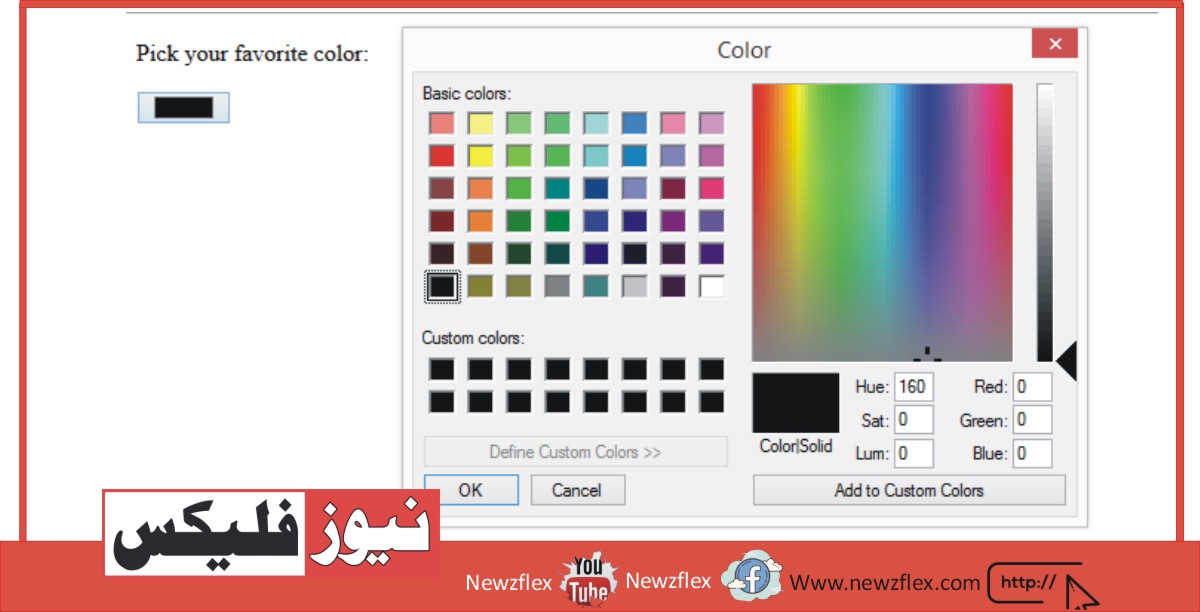
What HTML color is this?
HTML allows you to specify colors for elements using a variety of methods. Here are some of the ways to specify colors in HTML:
1. Color Names: HTML supports a variety of color names such as “red”, “green”, “blue”, “yellow”, etc. You can simply use the name of the color as a value for the “color” or “background-color” property.
<body style=”background-color: yellow;”>
<h1 style=”color: red;”>Hello World!</h1>
</body>
2. Hex Codes: You can also use hex codes to specify colors. A hex code is a six-digit code that represents a color, with each pair of digits representing the red, green, and blue values of the color. For example, #FF0000 represents pure red.
<body style=”background-color: #FFC0CB;”>
<h1 style=”color: #0000FF;”>Hello World!</h1>
</body>
3. RGB Values: RGB (Red, Green, Blue) values can also be used to specify colors in HTML. Each value is between 0 and 255 and represents the intensity of the corresponding color. For example, “rgb(255, 0, 0)” represents pure red.
<body style=”background-color: rgb(255, 255, 0);”>
<h1 style=”color: rgb(0, 0, 255);”>Hello World!</h1>
</body>
4. RGBA Values: RGBA (Red, Green, Blue, Alpha) values are similar to RGB values, but include an additional value for alpha which represents the opacity of the color. The alpha value is a number between 0 (completely transparent) and 1 (completely opaque).
<body style=”background-color: rgba(255, 255, 0, 0.5);”>
<h1 style=”color: rgba(0, 0, 255, 0.5);”>Hello World!</h1>
</body>
5. HSL Values: HSL (Hue, Saturation, Lightness) values are an alternative way to specify colors in HTML. Hue is a number between 0 and 360 that represents the color on the color wheel, saturation is a percentage value that represents the intensity of the color, and lightness is also a percentage value that represents the brightness of the color.
<body style=”background-color: hsl(60, 100%, 50%);”>
<h1 style=”color: hsl(240, 100%, 50%);”>Hello World!</h1>
</body>
Colors can be specified for various HTML elements, including text, backgrounds, borders, and more. By using colors effectively, you can create visually appealing and engaging web pages.
Background Color
In HTML, you can set the background color of an element using the `background-color` property. This property sets the background color of an element to a specified color value. Here are some examples:
1. Setting Background Color for the Body Element:
To set the background color of the entire page, you can set the `background-color` property of the `<body>` element. For example, to set the background color of the body to light blue, you can use the following code:
<body style=”background-color: lightblue;”>
<!– Content of the page –>
</body>
2. Setting Background Color for a Specific Element:
You can also set the background color of a specific element, such as a `<div>` or a `<p>`. For example, to set the background color of a `<div>` element to light green, you can use the following code:
<div style=”background-color: lightgreen;”>
<!– Content of the div –>
</div>
3. Using CSS to Set Background Color:
It is recommended to use CSS to style your HTML elements. To set the background color of an element using CSS, you can use the `background-color` property in your CSS file. For example:
<body>
<div class=”container”>
<!– Content of the div –>
</div>
</body>
.container {
background-color: lightyellow;
}
By using the `background-color` property, you can easily set the background color of HTML elements, and make your web pages more visually appealing.
Text Color
In HTML, you can set the color of the text in an element using the `color` property. This property sets the color of the text to a specified color value. Here are some examples:
1. Setting Text Color for the Body Element:
To set the text color of the entire page, you can set the `color` property of the `<body>` element. For example, to set the text color of the body to red, you can use the following code:
<body style=”color: red;”>
<!– Content of the page –>
</body>
2. Setting Text Color for a Specific Element:
You can also set the text color of a specific element, such as a `<div>` or a `<p>`. For example, to set the text color of a `<p>` element to blue, you can use the following code:
<p style=”color: blue;”>This text is blue.</p>
3. Using CSS to Set Text Color:
It is recommended to use CSS to style your HTML elements. To set the text color of an element using CSS, you can use the `color` property in your CSS file. For example:
<body>
<div class=”container”>
<p>This text is green.</p>
</div>
</body>
.container p {
color: green;
}
By using the `color` property, you can easily set the text color of HTML elements, and make your web pages more visually appealing.
Border Color
In HTML, you can set the color of the border of an element using the `border-color` property. This property sets the color of the border to a specified color value. Here are some examples:
1. Setting Border Color for a Specific Element:
To set the border color of a specific element, such as a `<div>` or a `<p>`, you can use the `border-color` property. For example, to set the border color of a `<div>` element to red, you can use the following code:
<div style=”border: 2px solid red;”>
<!– Content of the div –>
</div>
2. Using CSS to Set Border Color:
It is recommended to use CSS to style your HTML elements. To set the border color of an element using CSS, you can use the `border-color` property in your CSS file. For example:
<div class=”container”>
<!– Content of the div –>
</div>
.container {
border: 2px solid green;
border-radius: 10px;
padding: 10px;
}
In this example, we set the border color of the `.container` class to green and also set the `border-radius` and `padding` properties to give the element a more styled appearance.
By using the `border-color` property, you can easily set the border color of HTML elements, and make your web pages more visually appealing.
Color Values
In HTML, there are several ways to specify color values. Here are some of the most common ways:
1. Color Names:
You can use color names to specify a color value. For example, you can use the color name `red` to specify the color red:
<p style=”color: red;”>This text is red.</p>
2. Hexadecimal Values:
You can use hexadecimal values to specify a color value. Hexadecimal values are a combination of numbers and letters that represent the amount of red, green, and blue in a color. For example, the hexadecimal value `#FF0000` represents the color red. Here’s an example of how to use a hexadecimal value:
<p style=”color: #FF0000;”>This text is red.</p>
3. RGB Values:
You can use RGB values to specify a color value. RGB values represent the amount of red, green, and blue in a color as integers from 0 to 255. For example, the RGB value `RGB (255, 0, 0)` represents the color red. Here’s an example of how to use an RGB value:
<p style=”color: rgb(255, 0, 0);”>This text is red.</p>
4. RGBA Values:
You can use RGBA values to specify a color value. RGBA values are similar to RGB values, but they also include an alpha channel that represents the opacity of the color. The alpha channel is represented as a value between 0 and 1. For example, the RGBA value `rgba(255, 0, 0, 0.5)` represents the color red with an opacity of 0.5. Here’s an example of how to use an RGBA value:
<p style=”color: rgba(255, 0, 0, 0.5);”>This text is red with 50% opacity.</p>
By using these different ways to specify color values, you can create a wide range of colors in your HTML elements.








